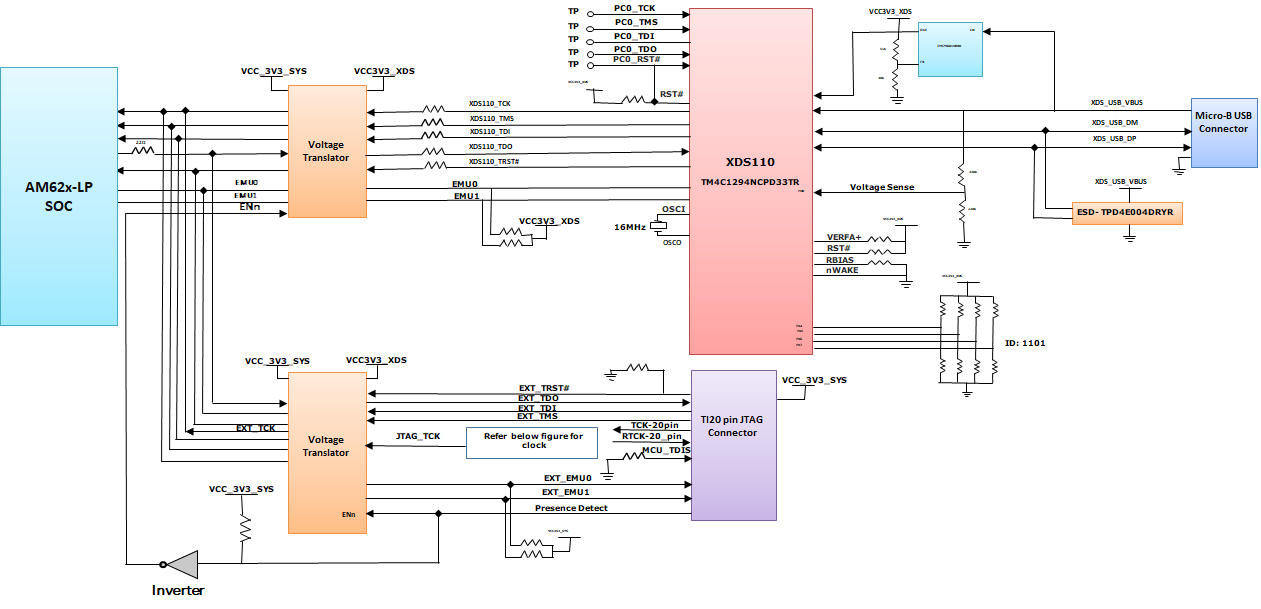SPRUJ51 june 2023
- 1
- 1Abstract
- 2EVM Revisions and Assembly Variants
- Trademarks
-
3System Description
- 3.1 Key Features
- 3.2 Functional Block Diagram
- 3.3 AM62x-Low Power SK EVM Interface Mapping
- 3.4 Power ON OFF Procedures
- 3.5
Peripheral and Major Component Description
- 3.5.1 Clocking
- 3.5.2 Reset
- 3.5.3 OLDI Display Interface
- 3.5.4 CSI Interface
- 3.5.5 Audio Codec Interface
- 3.5.6 HDMI Display Interface
- 3.5.7 JTAG Interface
- 3.5.8 Test Automation Header
- 3.5.9 UART Interface
- 3.5.10 USB Interface
- 3.5.11 Memory Interfaces
- 3.5.12 Ethernet Interface
- 3.5.13 GPIO Port Expander
- 3.5.14 GPIO Mapping
- 3.5.15 Power
- 3.5.16 AM62x-Low Power SK EVM User Setup and Configuration
- 3.5.17 Expansion Headers
- 3.5.18 Push Buttons
- 3.5.19 I2C Address Mapping
- 4Known Issues and Modifications
- 5Revision History
- 6IMPORTANT NOTICE AND DISCLAIMER
3.5.7 JTAG Interface
 Figure 3-13 JTAG Interface Block
Diagram
Figure 3-13 JTAG Interface Block
DiagramThe pin-out of the cTI 20 pin JTAG connector are given in Table 3-6. A ESD protection part number TPD4E004 is provided on USB signals to steer ESD current pulses to VCC or GND. TPD4E004 protects against ESD pulses up to ±15-kV Human-Body Model (HBM) as specified in IEC 61000-4-2 and provides ±8-kV contact discharge and ±12- kV air-gap discharge.
| Pin No. | Signal |
| 1 | JTAG_TMS |
| 2 | JTAG_TRST# |
| 3 | JTAG_TDI |
| 4 | JTAG_TDIS |
| 5 | VCC3V3_SYS |
| 6 | NC |
| 7 | JTAG_TDO |
| 8 | SEL_XDS110_INV |
| 9 | JTAG_cTI_RTCK |
| 10 | DGND |
| 11 | JTAG_cTI_TCK |
| 12 | DGND |
| 13 | JTAG_EMU0 |
| 14 | JTAG_EMU1 |
| 15 | JTAG_EMU_RSTn |
| 16 | DGND |
| 17 | NC |
| 18 | NC |
| 19 | NC |
| 20 | DGND |
The pin-outs of the cTI 20 pin JTAG connector are given in the table above. A ESD protection part number TPD4E004 is provided on USB signals to steer ESD current pulses to VCC or GND. TPD4E004 protects against ESD pulses up to ±15-kV Human-Body Model (HBM) as specified in IEC 61000-4-2 and provides ±8-kV contact discharge and ±12- kV air-gap discharge.